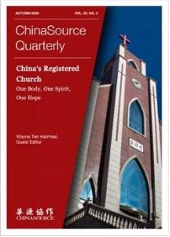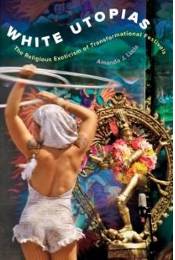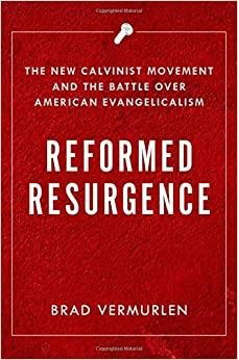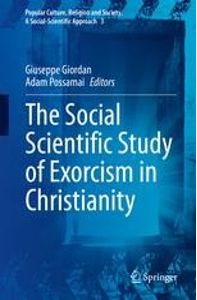
![]() The state of the patriotic or “Three-Self” church movement in China is the subject of the current issue of ChinaSource Quarterly
The state of the patriotic or “Three-Self” church movement in China is the subject of the current issue of ChinaSource Quarterly  (September 2020). Patriotic churches, which can be of various denominations, are registered with China’s government but are not necessarily subservient to the Communist Party in terms of their teaching and practices, as was the case in earlier years, according to several articles. Some congregations may join the association for mutual benefit and greater communication with the government, whose office of oversight had become weakened, writes editor Wayne Ten Harmsel. Yet the current Sinicization drive under Xi Jiping is likely to make the situation of registered churches and believers more difficult. An especially noteworthy article looks at how both registered and unregistered churches have adapted new media technology, such as WeChat, in the face of the pandemic, and will likely not abandon such involvement after the virus. The issue can be downloaded at: https://www.chinasource.org/about/publications/chinasource-quarterly/
(September 2020). Patriotic churches, which can be of various denominations, are registered with China’s government but are not necessarily subservient to the Communist Party in terms of their teaching and practices, as was the case in earlier years, according to several articles. Some congregations may join the association for mutual benefit and greater communication with the government, whose office of oversight had become weakened, writes editor Wayne Ten Harmsel. Yet the current Sinicization drive under Xi Jiping is likely to make the situation of registered churches and believers more difficult. An especially noteworthy article looks at how both registered and unregistered churches have adapted new media technology, such as WeChat, in the face of the pandemic, and will likely not abandon such involvement after the virus. The issue can be downloaded at: https://www.chinasource.org/about/publications/chinasource-quarterly/
![]() “Transformational” festivals—from Burning Man to Wanderlust—have served as institutional carriers of a countercultural spirituality and are the subject of Amanda J. Lucia’s provocative new book White Utopias (University of California Press, $29.95). As its title implies, Lucia argues that the white racial composition of these festivals goes a long way to explaining their growth and their use of one of “native” forms of spirituality. The book argues that these festivals appropriate indigenous practices and traditions and then render them exclusive even as they promote an “inclusive” spiritual community. In fact, Lucia finds in her ethnographic study that it is the homogenous nature of these events that resonate with participants, giving them a feeling of finding a spiritual home.
“Transformational” festivals—from Burning Man to Wanderlust—have served as institutional carriers of a countercultural spirituality and are the subject of Amanda J. Lucia’s provocative new book White Utopias (University of California Press, $29.95). As its title implies, Lucia argues that the white racial composition of these festivals goes a long way to explaining their growth and their use of one of “native” forms of spirituality. The book argues that these festivals appropriate indigenous practices and traditions and then render them exclusive even as they promote an “inclusive” spiritual community. In fact, Lucia finds in her ethnographic study that it is the homogenous nature of these events that resonate with participants, giving them a feeling of finding a spiritual home.
 The view on the appropriation of indigenous spirituality has often been associated with critiques of the New Age and other syncretistic movements, though Lucia adapts the argument to current critical theories on race and “white supremacy.” Thus, the author writes of the irony that such practices and teachings as meditation, yoga, use of the psychedelic Peyote, and sweat lodges are detached from their hierarchical and exclusive traditional religions and democratized to be seen as universal and “authentic” to spiritual consumers (even as the “burners” in the Burning Man festival inveigh against consumption and capitalism). But this “expansive and universalistic ethos ends up denying the authority of nonwhite voices to represent the authority of their traditions,” Lucia writes. Whether or not the reader agrees with the critical “whiteness” theory that Lucia employs throughout this book, it provides compelling accounts of participants and the value they find in these festivals and their rituals and practices. Lucia herself finds hope that the spiritual community and unconventional mystical practices in these “counter modern” gatherings have the potential to create the “communitas in shared human experience.”
The view on the appropriation of indigenous spirituality has often been associated with critiques of the New Age and other syncretistic movements, though Lucia adapts the argument to current critical theories on race and “white supremacy.” Thus, the author writes of the irony that such practices and teachings as meditation, yoga, use of the psychedelic Peyote, and sweat lodges are detached from their hierarchical and exclusive traditional religions and democratized to be seen as universal and “authentic” to spiritual consumers (even as the “burners” in the Burning Man festival inveigh against consumption and capitalism). But this “expansive and universalistic ethos ends up denying the authority of nonwhite voices to represent the authority of their traditions,” Lucia writes. Whether or not the reader agrees with the critical “whiteness” theory that Lucia employs throughout this book, it provides compelling accounts of participants and the value they find in these festivals and their rituals and practices. Lucia herself finds hope that the spiritual community and unconventional mystical practices in these “counter modern” gatherings have the potential to create the “communitas in shared human experience.”
![]() A book-length study of the phenomenon of “new Calvinist” congregations, ministries, and networks has been a long time coming (RW has reported on the movement since the late 1990s), but Brad Vermulen’s Reformed Resurgence (Oxford University Press, $99) ably fills that need, providing an in-depth look at a vital movement within evangelicalism. One might even say that the study has a retrospective quality to it (focusing on the years 2012-2016), even as Vermulen provides an update of this fast-changing movement in an appendix, since many of these networks and their leaders have seen defections and other losses experienced by evangelicals as a whole. Vermulen distinguishes the “new Calvinists” from other Reformed churches and denominations in their strongly evangelistic and activist stance typified by leaders and groups such as Tim Keller of Redeemer Presbyterian Church, John Piper, Acts 23 Network, Mars Hill Church of Seattle, Mark Dever of Capitol Hill Baptist Church.
A book-length study of the phenomenon of “new Calvinist” congregations, ministries, and networks has been a long time coming (RW has reported on the movement since the late 1990s), but Brad Vermulen’s Reformed Resurgence (Oxford University Press, $99) ably fills that need, providing an in-depth look at a vital movement within evangelicalism. One might even say that the study has a retrospective quality to it (focusing on the years 2012-2016), even as Vermulen provides an update of this fast-changing movement in an appendix, since many of these networks and their leaders have seen defections and other losses experienced by evangelicals as a whole. Vermulen distinguishes the “new Calvinists” from other Reformed churches and denominations in their strongly evangelistic and activist stance typified by leaders and groups such as Tim Keller of Redeemer Presbyterian Church, John Piper, Acts 23 Network, Mars Hill Church of Seattle, Mark Dever of Capitol Hill Baptist Church.
The new Calvinists are also marked by their denominational diversity, embracing conservative Reformed denominations, such as the Presbyterian Church in America, but also Reformed and Southern Baptists, charismatic megachurches, and non-denominational church planting networks (and a small but influential African-American contingent). Vermulen notes that the size of the new Calvinism is difficult to estimate; it has a large but diffuse presence on social media (John Pieper has a Twitter following of 800,000), with anywhere from three million to nine million followers. Through participant-observation and in-depth interviewing, the author argues that much of the Reformed resurgence (whatever its size) represents a contestation and a protest force among evangelicals over theology and social issues, even if many of its rank-and-file church members are unaware of these  matters and their congregations’ Calvinist convictions. The new Calvinists have specifically targeted changes wider evangelical world involving the perceived rise of postmodern and therapeutic influence and namely such culture war issues on gender, sexuality, and abortion. The new Calvinists’ firm and certain stance on these contested issues and their blending of tradition with innovation has attracted a large number of young adults, giving it an advantage in competing with other theological and church movements, such as the postmodernist Emerging church movement, within the evangelical world. The new Calvinists have also pioneered in urban ministry (under such leaders as Tim Keller), engaged the culture and the arts, and has sought to be non-partisan (while veering to the right on most issues). Vermulen concludes that with the retirement or deaths of important leaders and scandals at some key new Calvinist churches (such as Mars Hills), the movement may have peaked in its “emotional energy.” But the large and engaged number of new Calvinist laity and the web of institutions, suggests that the movement will endure, providing an alternative worldview within evangelicalism.
matters and their congregations’ Calvinist convictions. The new Calvinists have specifically targeted changes wider evangelical world involving the perceived rise of postmodern and therapeutic influence and namely such culture war issues on gender, sexuality, and abortion. The new Calvinists’ firm and certain stance on these contested issues and their blending of tradition with innovation has attracted a large number of young adults, giving it an advantage in competing with other theological and church movements, such as the postmodernist Emerging church movement, within the evangelical world. The new Calvinists have also pioneered in urban ministry (under such leaders as Tim Keller), engaged the culture and the arts, and has sought to be non-partisan (while veering to the right on most issues). Vermulen concludes that with the retirement or deaths of important leaders and scandals at some key new Calvinist churches (such as Mars Hills), the movement may have peaked in its “emotional energy.” But the large and engaged number of new Calvinist laity and the web of institutions, suggests that the movement will endure, providing an alternative worldview within evangelicalism.
![]() The Social Scientific Study of Exorcism in Christianity (Springer, $89), edited by Giuseppe Giordan and Adam Possamai, collects several fascinating accounts and studies of exorcists and exorcism at a time and in places where these type of rituals and phenomena are supposed to be extinct due to secularization. The editors note that the growing significance of the rite of exorcism
The Social Scientific Study of Exorcism in Christianity (Springer, $89), edited by Giuseppe Giordan and Adam Possamai, collects several fascinating accounts and studies of exorcists and exorcism at a time and in places where these type of rituals and phenomena are supposed to be extinct due to secularization. The editors note that the growing significance of the rite of exorcism  is both a challenge to secularization and a sign of how religion is less beholden to experts as it incorporates elements of magic and therapy. The book’s case studies capture the many hues of contemporary exorcism—from a new cadre of exorcists commissioned by the Vatican to the Pentecostal Universal Church of the Kingdom of God in Brazil to a controversial case of Eastern Orthodox nun-exorcists in Romania—and how their practitioners borrow techniques and teachings from each other. Most of the authors bracket the question of whether there is validity to exorcists’—and the exorcized—claims of actual demonic possession, but they often report that the various ceremonies can have beneficial results from the afflicted. More central to this collection is the way that exorcism is a source of competition between its various providers in the religious marketplace. For instance, one chapter argues that the Catholic Church in Brazil (and much of the West) revived and adapted its rite of exorcism as a result of competition with Pentecostals and their deliverance ministries.
is both a challenge to secularization and a sign of how religion is less beholden to experts as it incorporates elements of magic and therapy. The book’s case studies capture the many hues of contemporary exorcism—from a new cadre of exorcists commissioned by the Vatican to the Pentecostal Universal Church of the Kingdom of God in Brazil to a controversial case of Eastern Orthodox nun-exorcists in Romania—and how their practitioners borrow techniques and teachings from each other. Most of the authors bracket the question of whether there is validity to exorcists’—and the exorcized—claims of actual demonic possession, but they often report that the various ceremonies can have beneficial results from the afflicted. More central to this collection is the way that exorcism is a source of competition between its various providers in the religious marketplace. For instance, one chapter argues that the Catholic Church in Brazil (and much of the West) revived and adapted its rite of exorcism as a result of competition with Pentecostals and their deliverance ministries.
Contributors also focus on the demand for as well as the supply of exorcism, as they argue that the explosion of interest in the occult starting in the 1960s and 70s (helped by such horror films as The Exorcist) provided a ready-made market of people seeking spiritual assistance with demonic influences (it is made clear that full-blown demonic exorcism cases, in contrast to deliverance prayer ministry, are still relatively rare). The relation of demonic oppression and possession to psychiatry and mental illness is covered by several contributors, who find that the latter is usually ruled out before exorcism and deliverance is attempted and even in those cases, there is cooperation as well as the conflict between religion and therapy. This is driven home in a compelling chapter on the aftermath of an exorcism in Florida where a clear resolution to this affliction is not easily found. The individual under question experienced a catharsis from the ceremony but still suffered the stigmatizing impact of the experience years after, requiring therapy. A religious professional dealing with such cases said long-term effects from deliverance attempts are not uncommon, especially when there is a negative community response to such activity. In such instances, support structures provided by the family and religious community are important. In attempting to explain the burgeoning supply and demand of exorcism, the editors suggest that it may be the result the “over-policing” of the devil engaged in by religious specialists as they regularly point out demonic influence in society. They add that the interchanges and syncretism of practices and teachings evident in contemporary exorcism—if not its subject matter— are mediated by the processes of migration, globalization and rationalization of religion.